There was this recent trend on Facebook to post Ten Albums across Ten Days. Some versions involved just posting the cover, others involved writing. Me being me, I did the written version. It’s been a while since I posted anything here, so I thought I’d take the content and turn it into an article here, editing only for the occasional typo and to reflect the changed medium. Note that this isn’t strictly my ‘all time top 10 albums’, certainly not on a pure musical/production level. It’s just the 10 albums about which I thought I could spin the best tale.
Day One: Ian Dury – New Boots and Panties
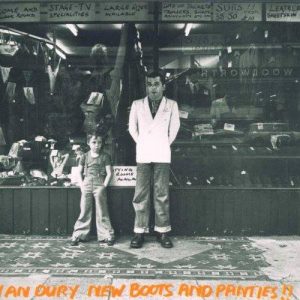 When I was a kid, my dad played me this and the follow-up ‘wallpaper album’ due to the number of references to the part of London/Essex borders in which we lived. Named after the only two items of clothing Dury bought new (otherwise a thrift shop man), this was a Blockheads-played album in all but name (Dury, with only one fully functioning arm, could not be expected to record solo). Indeed, the Blockheads took their name from the song of the same name, an insulting punk rocker from an act that trod the fringes of the movement without ever being ‘part of it’ – only this and Blackmail man are truly ‘punk rock’
When I was a kid, my dad played me this and the follow-up ‘wallpaper album’ due to the number of references to the part of London/Essex borders in which we lived. Named after the only two items of clothing Dury bought new (otherwise a thrift shop man), this was a Blockheads-played album in all but name (Dury, with only one fully functioning arm, could not be expected to record solo). Indeed, the Blockheads took their name from the song of the same name, an insulting punk rocker from an act that trod the fringes of the movement without ever being ‘part of it’ – only this and Blackmail man are truly ‘punk rock’
“Billericay Dickie” is the centrepiece, a showcase for Dury’s serial rhyme artistry. Despite the carnival music, Dury had as much disdain for the cocky Essex Casual depicted in the song as I do (watch a live recording if you want to see the effect). The rock’n’roller tribute ‘Sweet Gene Vincent’ is a wave back to Dury’s true influences, but the album also has a heartfelt side. “My Old Man” is about his later father, a man he had an on-off relationship with. And opener “Wake Up And Make Love To Me”? I’ll let you draw you own conclusion.
Whilst it’s not clear how much of this album is about real people and how much is a product of Dury’s imagination, it’s certainly got the air of the ‘real world’ about it. It’s about everyday people, everyday situations. Some references haven’t dated well, but if that is accepted as being of its time, it’s still worth as my first of ten entries.
Day Two – Front 242 – Tyranny >For You<
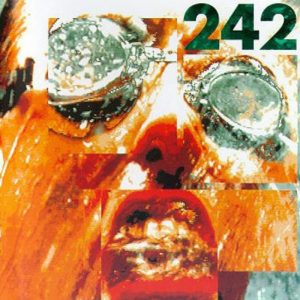 Many bands are missing out on this 10 albums thing due to having a number of very good albums, but suffer from a kind of ‘vote splitting’. The same thing nearly happened here, but I realized that this is me and Front 242 have to feature, come-what-may.
Many bands are missing out on this 10 albums thing due to having a number of very good albums, but suffer from a kind of ‘vote splitting’. The same thing nearly happened here, but I realized that this is me and Front 242 have to feature, come-what-may.
The 242 sound developed through the 80s and their most recognisable tunes were in fact on the album before, Front by Front. By 1993, they had flown off at a musical tangent (though I also liked UP EVIL). Somewhere between was this – the album that takes the 242 sound and gives it a depth they haven’t equaled since.
The opening track ‘Sacrifice’ is forgotten gem of their catalogue. Jean-Luc De Meyer could make a nursery rhyme sound ominous, but add the foreboding synth rising from the mix like the walls of some vile citadel and you finally realise that the Frontmen don’t only do rhythm. They can create real atmosphere when then wish.
Tracks like ‘Rhythm of Time’ and ‘Moldavia’ follow, more in line with what came before but with a textural depth that sets them apart. ‘Neurobashing’ is a late album highlight, again proving that the complexity of the mix never get in the way of a hard-beating dance number.
But the centrepiece can only be one – Tragedy >For You<. The track where Front 242 showed they can indeed write songs, not just ‘tracks’. It’s my one regret about the current EBM revival that it’s focusing on very ‘technical’ music, often without vocals, and it’s at a cost of getting more tunes like this. This song does have a deeper personal resonance also – the better you know me, the more likely you are to understand why.
I was never going to do the ‘no writing’ version of this, was I?
Day Three – VNV Nation – Advance and Follow
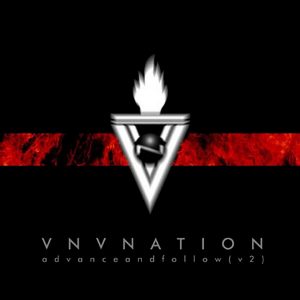 Music is one of few legitmate areas where one can go ‘off message’ and survive on the internet of 2018, but the connection so many feel to this band means even here I think I may be on thin ice. This debut album has been disowned by many fans and even to most extents by the band themselves, even afte the ‘v2’ refresh in 2001. And indeed my two favourite VNV songs are to be found on the next album. But this is about albums, and this particular recording, as a complete piece, somehow succeeds despite itself. It sums up everything that drew me to this band, and none of the flabby sentimentality that drove me away.
Music is one of few legitmate areas where one can go ‘off message’ and survive on the internet of 2018, but the connection so many feel to this band means even here I think I may be on thin ice. This debut album has been disowned by many fans and even to most extents by the band themselves, even afte the ‘v2’ refresh in 2001. And indeed my two favourite VNV songs are to be found on the next album. But this is about albums, and this particular recording, as a complete piece, somehow succeeds despite itself. It sums up everything that drew me to this band, and none of the flabby sentimentality that drove me away.
The album is bookended by two very martial-themed instrumentals, ‘Anthem’ the foreboding intro, ‘Fiume’ the victorious finale, likely to appeal more to Laibach fans than that lot who waved glow sticks in 2002-vintage Slimelight. The central musical theme of the album is essentially a kind of orchestrated EBM, which probably explains why the EBM tag stuck to everything they did since. When you listen to tracks like ‘After Fire’ and ‘Frika’, you still get that emotional connection to Ronan Harris’ proclamations, but the rough edges actually enhance the effect rather than counter it, in comparison to the saccharine-sweet clinical dullsville that ‘Transnational’ turned out to be back in VNV’s 2013 fall-from-grace.
The song pairing ‘Serial Code’ and ‘Serial Killer’ are best enjoyed as a single piece, a treat for lovers of minor key chord progressions and electro-industrial percussive lines from the mid-90s. ‘Cold’ is pure EBM – if you think you know it because you heard the Mig remix, well, you don’t. Get a load of this and discover a true body beat. ‘Amhran Comhrac’ does provide some relief from the gloom – a kind of celtic fiddle piece brought up to industrial strength.
The version you’re likely to find these days is the aforementioned 2001-issued V2, partially rerecorded and reproduced, but the original songs intact, only with production up to early-00s Logic Pro standards (as in, Music Tech people will still pick holes but good enough for the rest of us). Also adds the compilation tracks from the time, including a surprisingly good version of ‘Circling Overland’. I don’t think VNV ever recorded a cover again.
And yes, I do own both versions on CD. The original Discordia 1995 version was acquired for pocket change in the Music & Video Exchange in 2009, before Discogs and co allowed staff in such shops to find out what such things are worth. I’ve only ever seen one other original copy of the album – if you got my ‘Tragedy For You’ reference yesterday, you might work out where I saw it. Indeed, this album is in my mind a true successor to the sound of early-90s 242, so it’s right that it comes a day after I waxed lyrical about that.
Day Four – Apoptygma Berzerk – 7
 It’s always got me that our scene music has existed in a hermetically-sealed bubble, and the world outside doesn’t acknowledge it’s existence, even when it produced something they might like. This album briefly broke that chain. Discovered thanks to the likes of DJs Rob Ruein (Hollywoods, Romford) and Rex (Full Tilt), I finally acquired it in December 1999, my first of many visits to Resurrection Records in Camden. Took it back to my student residence, and by the end of the academic year, it had been lent out to more people that any CD I owned before of since.
It’s always got me that our scene music has existed in a hermetically-sealed bubble, and the world outside doesn’t acknowledge it’s existence, even when it produced something they might like. This album briefly broke that chain. Discovered thanks to the likes of DJs Rob Ruein (Hollywoods, Romford) and Rex (Full Tilt), I finally acquired it in December 1999, my first of many visits to Resurrection Records in Camden. Took it back to my student residence, and by the end of the academic year, it had been lent out to more people that any CD I owned before of since.
The earworm is of course ‘Love Never Dies Pt 1’, that ascending synth line and O Fortuna sampling giving an instant hook that draws in the kind of people that didn’t think they cared for this ‘goth thing’. Perhaps more pertinent these days is ‘Non-Stop Violence’, inspired by Stefan Groth’s run-in with Norwegian national service commitments. Perhaps in these increasingly socially-aware times, it can be regarded as something of a rallying call against the still too-prevalent patriarchal requirement that makes men (willing or unwilling) into armed aggressors.
But the strength of this album is also found in how well it plays out it’s influences. ‘Mourn’ is more electro-rock than EBM or darkwave, sampling “Nirvana covering Bowie” in a kind of ‘why not pay tribute to both of them in one go’. If you remembered Apop’s first album, you’ll find a connection in ’25 Cromwell Street’. It’s is a slow-seething dark electro piece, a cynical ‘good riddance’ to a very British serial killer. But if you just wanted to dance without having to worry about lyrical interpretation, “Deep Red” and “Half-Asleep” will fulfil your needs.
One thing Apop flopped on massively on every subsequent album was thier big, slow synth-ballad, but ‘Near’ avoids the schmaltzy excesses and trite lyricism of later works and adds yet at another angle to an already-diverse album. Indeed, this is one of the only CDs I’ve ever owned where I regard listening to the ‘hidden tracks’ at the end as part of the overall experience – a reprise of ‘Non-Stop Violence’, an adventure through samples and noise loops and synthpoppy finale that will forever be known as ‘Untitled Too’.
A note about versions – the current edition of this album has critical samples removed due to various complicated legalities (and I told Copyright was supposed to be protective, not destructive?). A 1990s version is what you’re after – the 1998 Metropolis version is the best as you get a couple of bonus tracks from the EPs – a dancey remix of ‘Mourn’ (which was the preferred live version for a while) and a nice cover of OMD’s Electricity. These are inserted into the running order rather than just being tacked on, and make a great album better.
Day Five – Underworld – Dubnobasswithmyheadman
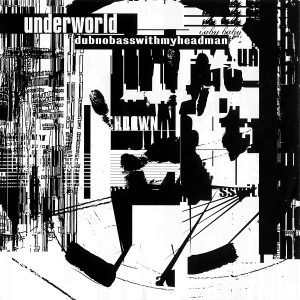 The second album that bears some kind of local relevance to me, even mentioning my home town of Romford at one point, but that’s not enough on it’s own. To understand why this album features, you need to understand something about how “dance music” traditionally sold itself. It was a format focused on the single (in the 80s, the iconic ‘twelve inch’), albums typically being a compilation of existing tracks plus some token remixes and studio-reject filler.
The second album that bears some kind of local relevance to me, even mentioning my home town of Romford at one point, but that’s not enough on it’s own. To understand why this album features, you need to understand something about how “dance music” traditionally sold itself. It was a format focused on the single (in the 80s, the iconic ‘twelve inch’), albums typically being a compilation of existing tracks plus some token remixes and studio-reject filler.
Also, dance artists got associated with one genre and a basic musicology let you determine “this is house, this is trance, this is techno, etc”. Finally, it was predominantly an instrumental art, vocals coming from samples or guest singers, not from someone intrinsically part of the project. The 1990s saw these standards begin to crumble, when dance music finally discovered that it could breach it’s own self-set rules. But no album managed to assault all three standards listed above quite like this one.
Underworld themselves had only recently entered the dance scene, indeed many forget they were previously a minor new wave act. This is fortunate, as no-one taught them the rules of electronica (oh, how I hate that term), and hence they broke them all anyway. The nine electronic compositions on this album are strung together in such a way that they work as a continuous piece, yet each one is surprisingly resistant to description. If they felt it was right to break from conventional dance music structures, add guitars or do-whatever-made-the-track-better, they did it. But never did it for the sake of being different. It’s like whilst they didn’t follow any particular rule-book, they at least knew such a thing existed.
The thread running through is Karl Hyde’s stream-of-consciousness vocals. Stringing together isolated words and phrases in such a manner that he could be looping a few words one moment and flying off at tangents the next, it all comes together to form an album that has musicians doing what they want, but producing a result that takes the audience with them, not leave them behind in a cloud of self-indulgent art-wank.
The true sweet spot of this technique comes with ‘Dirty Epic’, a delirious ten minutes of electronics that keeps on morphing, changing and building into the epic that it says it. But there is one track that is greater still – ‘Cowgirl’. The original demo (C69 Mix) indicates it began as a lengthy Karl Hyde monologue, but they eventually sussed that by looping key phrases, tightening up the structure and introducing a scathing acid synth lead, they would have a ten-star dance anthem on their hands. And that’s what they did. One of the truly great Terminates Here moments came when I dropped this in at Reptile in January 2012 – it was like meeting an old friend you hadn’t seen in years.
And if you wanted to know the true crossover appeal of this album – their American label at the time were Wax Trax! If the previous entry gave a purely ‘scene’ album that regular people liked, this is the counterpart, a dance album that even our own collective could appreciate. I may despise much about ‘dance music culture’, its elitism, its fetishisation of genres every few years, it’s “DJ is the star” mentality and it’s association with pretentious, overpriced venues. But I can’t deny that they made some great music.
Day Six – Project Pitchfork – !Chakra:Red!
 This is another case where I’ve avoided the album with the biggest hit rate of out-and-out anthems (that would be ‘Daimonion’) and instead gone for an album that works best as a continuous piece. And this is despite the fact that there were so many reasons why this album should never had worked. Some purist fans might have regarded it as a let-down after “Alpha-Omega” (another hit-heavy release), but I prefer to see it as a band saying “let’s not rest on our laurels”. They went a bit far off course come the 00s, but for now they are safe.
This is another case where I’ve avoided the album with the biggest hit rate of out-and-out anthems (that would be ‘Daimonion’) and instead gone for an album that works best as a continuous piece. And this is despite the fact that there were so many reasons why this album should never had worked. Some purist fans might have regarded it as a let-down after “Alpha-Omega” (another hit-heavy release), but I prefer to see it as a band saying “let’s not rest on our laurels”. They went a bit far off course come the 00s, but for now they are safe.
Breakbeats and industrial-metal guitars both featured significantly for the first time, but it’s still got that Pitchfork sound. There is a fine art to borrowing influences from currently-popular styles (drum’n’bass and guitar-driven industrial were both big at the time) and not letting them swamp your sound and making you look like a bandwagon-jumper low on fresh ideas of your own. Not a problem here – it’s still Spilles, Schuber and (then newish recruit) Jansen at work. Only this album saw a significant split in writing responsibilities – all the band members played a role in writing this album (previous efforts were primarily Spilles-led in this area).
‘Human Crossing’ opens the album, their latest anti-animal testing album, reintroducing ‘Rat 41’ from the Dhyani album. I’ve always had a thing for the way this track speaks from the rats point of view, reinforcing how creative Pitchfork are and always have been with writing social awareness themes into their songs. ‘2069AD’ is a breakbeat-tech-metal post-apocalyptic surge that triggered a mosh-pit the last time I remember them playing it live (years ago).
The other ‘endtimes anthem’ is if anything even stronger in impact – ‘God Wrote’ sums up everything this album stands for, musically and conceptually, and it’s quite rightfully got a near-permanent place in their live set. That massive bassline (play it though a decent PA to feel it properly) isn’t a style to which I’m usually accustomed, but here it just works. Pity they play it so early at their shows – I usually fuck up my voice yelling out the lyrics too loudly.
The second half of the album requires more active listening to appreciate. ‘December Sadness’ is a drawn-out journey through dark electronics that ultimately proves to be very touching. A trio of tracks then hark back to the ‘sexual’ themes of the Corps D’Amour EP, before the quite unexpected finale of ‘I’ll Find My Way Home’. Not many remember the early 80s collaboration between Vangelis and Jon Anderson (on hiatus from Yes at the time), but I do, always liked it, and was more than pleased to find a band who rarely covers songs reviving one of their hits in the process. It’s the last act of an album that avoids the obvious wherever it can, and never feels worse for having done so.
Day Seven – Killing Joke – Killing Joke (2003)
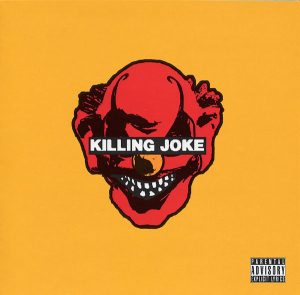 Killing Joke have two self-titled albums and either one would be a worthy entry here. But their 1980 debut has been well-covered in the established music press, whilst I was a relatively ‘late arrival’ to it. This album, meanwhile, was what turned me from a casual fan of the ‘Joke to a near obsessive. And it came when the band returned from their lengthiest hiatus to date. It wasn’t quite the ‘classic line-up’, but getting Dave Grohl to do guest drums was a handy way of getting an amicable resolution to all the old Eighties/Come As You Are arguments.
Killing Joke have two self-titled albums and either one would be a worthy entry here. But their 1980 debut has been well-covered in the established music press, whilst I was a relatively ‘late arrival’ to it. This album, meanwhile, was what turned me from a casual fan of the ‘Joke to a near obsessive. And it came when the band returned from their lengthiest hiatus to date. It wasn’t quite the ‘classic line-up’, but getting Dave Grohl to do guest drums was a handy way of getting an amicable resolution to all the old Eighties/Come As You Are arguments.
Indeed, having a rock ‘name’ in the band was probably useful in re-establishing the name in an era of music that wasn’t likely to be that conducive to an old 80s band making a comeback. But the moment I heard that jagged riff that opens ‘The Death And Resurrection’ show, I knew they were essentially back-on-track. For that riff to then develop into a seven-minute mythological epic, though? That’s not the sound of a band going through the motions. That’s the sound of a band rediscovering what made them great. And THEN building on it.
Equally capable of slow, seething, grinds (Total Invasion) and all-out apocalyptic riff warfare (ASTEROIDDDDD!!!), the album shows a band wishing to grind an axe both musically and politically. The social aspects of this album might be more typical of the ‘Dubya-Blair’ era than the ‘Trump-May’ era, but that doesn’t mean the issues are any less important – it’s actually useful to be reminded in some cases. It might of came out around the start of the Iraq war, but this is far from a single-issue recording. If you’ve quietly accepted the growth of nightclub ID scanning, take a listen to ‘Implant’ and then still tell me it’s still a good thing.
The album rarely lets the intensity drop, though the huge oceans of guitar noise that form ‘You’ll Never Get To Me’ occasionally let a note of redemption rise forth, the most heartfelt song on the album – indeed the line ‘Survival is my Victory’ is something of a personal motto. I even got the underlying message of ‘Dark Forces’ – a track most critics panned for being slow and boring. Sometimes you have to live with an album to truly ‘get’ what it’s about.
But remember this came out in 2003 – industrial music was at it’s most anti-guitar ever, 80s DJs found this ‘too metal’, as did the emerging deathrock revival scene (who’d happily play their early stuff at the right moment), whilst the metal scene only paid attention to this due to Grohl’s guest appearance, otherwise occupied with whatever-the-Kerrang-kiddies-were-into-then. So the audience for this album proved to be surviving fans from Killing Joke’s original era. And people who knew a good thing when they heard one.
Day Eight – Fear Factory – Demanufacture
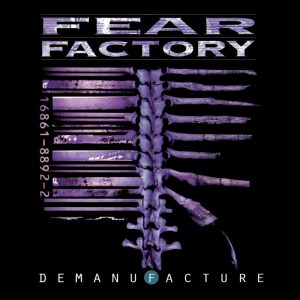 Fear Factory had a mission statement that was hinted at on their death metal debut “Soul of a New Machine” and given a more blatant push on Front Line Assembly remixed EP “Fear Is The Mindkiller”. But it was here that their true purpose was clear to all. You need only look at the cover to get a pretty good idea.
Fear Factory had a mission statement that was hinted at on their death metal debut “Soul of a New Machine” and given a more blatant push on Front Line Assembly remixed EP “Fear Is The Mindkiller”. But it was here that their true purpose was clear to all. You need only look at the cover to get a pretty good idea.
They actually rejected the initial mix as being to close to their debut. They were after a very “mechanical” sound, and a certain Rhys Fulber (he of aforementioned FLA) was one of those called upon to fix it. The end result was riffs that resembled machine guns, beats so precise that some accused them of using a drum machine (they didn’t) and a true feeling of man vs machine.
The machine in question took many forms – government, religion, gun ownership, even rape culture. The opening, title track is a good a statement of intent as you’ll ever get, but my favourite was always “Self-Bias Resistor” for it’s ‘stand up and fight back’ drive that saw me through some difficult times back in the late 90s.
Burton C Bell really masters his alternating death growl-clean vocal style where. His singing voice has a hymn like quality at times, particularly potent on the religious statements “Zero Signal” and “Pisschrist”. The later song also has personal resonance – the prize for surviving my first mosh pit was being down the front for this song.
I do like a degree of “light and shade” on even the most extreme albums and sure enough this one has a couple. “Dog Day Sunrise” is an avoid-the-obvious take on an old Head Of David song, a salute to genre veterans still tuned in. Album closer “A Therapy For Pain” takes an old demo and the production wizardry turns into a nine minute doom epic.
This album now comes as a double CD with the “Remanufacture” remix album included – probably the best remix album I’ve ever heard. Rhys Fulber gets a good look in here to, as does a not-very-famous-yet Junkie XL. As for turning “H-K” into gabber-metal? It would never had worked with lesser material than this……
Day Nine – Diary Of Dreams – One Of 18 Angels (2000)
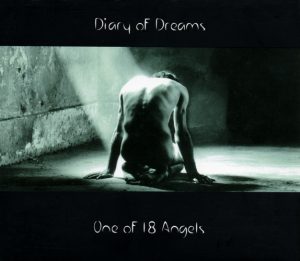 Judging from the responses so far, this might be one of my more contentious entries, as many of the people who commented on the earlier albums have not held this band in such great regard. But it’s still “my post, my rules” and this album has to feature.
Judging from the responses so far, this might be one of my more contentious entries, as many of the people who commented on the earlier albums have not held this band in such great regard. But it’s still “my post, my rules” and this album has to feature.
This was actually the fifth Diary of Dreams studio album. By the second (End Of Flowers), they had their atmosphere sorted. The third (Bird Without Wings) saw them get to grips with electronic rhythms, and the fourth (Psychoma?) brought a new lyrical complexity. This album, however, saw everything come together. The looping piano that opens the album as “Rumours About Angels” is joined with cathedral-sized reverb as the percussion kicks in, and when Adrian Hates’ voice enters, we truly are in epic gloom-goth territory.
There are tracks here you may be familiar with – the klaxon-esque lead of “Butterfly:Dance!” or the deep synth groove of “Chemicals” gave us two of the greatest darkwave dancefloor hits ever written – indeed if I was to do an all-time songs list, “Chemicals” would get into my top five without a second thought. But the strength is in the depth here. Every song seems to be questioning the purpose of our existence in some manner, and Adrian’s lyrics have a remarkable turn of phrase for a man who is really writing in his second language.
The slow piano ballad ‘Colorblind’ is the kind of tear-jerker than even breaks though to this heart – how can I not be deeply affected by a line like “The world has now forgotten you, for you have done that – first” given what was happening in my life when I first heard this. And this was only track eight of eleven. It could easily have closed the album but the final three tracks simply build from here, each one sounding more terminal, more final than the one before.
The later DoD albums might have upped the hit rate of ‘dark dance hits’ – their follow-up album ‘Freak Perfume’ actually had more potential DJ material on it. But they never again managed to issue an album that worked as well as a consistent piece, being hit-and-miss with the ‘slow tunes’ in particular. This album had it all.
Day Nine-and-a-half – The Near Misses
This is my extra-curricular bit – some people tried to guess albums that are coming and before I do the last one, I need to give a wave to my near misses.
Some bands suffered from vote-splitting, due to having several excellent albums that ultimately competed with each other too much for a space. The key bands to drop out here were Covenant and Rammstein, both with no less than four albums that were candidates. In the case of Covenant, the late 90s and early 00s were a sweet spot too spread out to focus on one album alone, whilst with Rammstein, I seriously considered putting “Mutter” in, it dropping only due to it being second in my mind to the live show based on said album, written about at length last year.
Bands like Mesh, Rotersand, The Beauty of Gemina, The Human League, Depeche Mode, Megaherz, OMD, In Extremo, Invincible Spirit, Ladytron, The Prodigy, The Sisters of Mercy and Star Industry were candidates, too. Old favourites Jean-Michel Jarre and Mike Oldfield were also thereabouts but not there.
Other albums had more specific reasons for omission:
Earth Loop Recall – Compulsion
A bolt-from-the-blue 00s electronic rock cult gem that was on my player constantly for about a year post-release, but unfortunately has ‘too much history’ in subsequent occurrences to go into in detail here. Lots of stuff lots of people don’t want raised again.
Suicide Commando – Mindstrip, Punto Omega – (Self-Titled Debut)
My favourite two examples of harsh-vocal EBM, but I’ve moved on from that sound.
Nitzer Ebb – That Total Age and DAF – Alles Ist Gut
Front 242 made it in, these two might have given them competition a few years back. The only thing that stopped them was how easily their sound was replicated by bands like Spetsnaz and Jäger 90. It does knock the mystique a bit.
Marilyn Manson – Antichrist Superstar
An album that took me through one of the darkest eras of my life, almost exactly 20 years ago. But given the internal changes I’ve made and also subsequent events relating to the band members of the time, not one to glorify in 2018.
System Of A Down – Mezmerize
I got too much stick for liking this in 2005. Ranking it ahead of the bleep albums of the same year AND ahead of the fan-preferred ‘first two’ was the sign of the beginning of the end of EOL-Audio. Sometimes people only want to read what they want to see.
So, one more to go……
Day Ten – Nine Inch Nails – The Downward Spiral
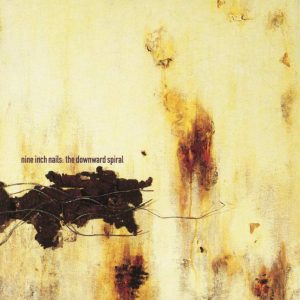 Who saw this coming? It’s actually something of a pity that this album features here on a day where many are saying relatively negative things about NIN due to the awkward nature of their scheduled live appearances – the blame might ultimately fall with ticket and booking agents, but this is 2018 so can I say “complicit”? Trent Reznor has enough string-pulling power to have done this differently had he wanted to.
Who saw this coming? It’s actually something of a pity that this album features here on a day where many are saying relatively negative things about NIN due to the awkward nature of their scheduled live appearances – the blame might ultimately fall with ticket and booking agents, but this is 2018 so can I say “complicit”? Trent Reznor has enough string-pulling power to have done this differently had he wanted to.
But Trent has never taken the easy route, and as far as their studio works go, this album is the central reference point for the NIN sound and the work ethic behind it. Whilst there is a common thread running through the album, every song essentially reinvents the wheel. Be it synths that sound like guitars, guitars that sound like synth, percussion that may or may not be based on conventional ‘drums’ and song structures that ‘might’ follow a conventional rock format, but more often do not. Too often, industrial and rock have come together to sound like a 90s alt band with an added analogue synth. Not here.
The central theme of the descent of a central figure in their own Downward Spiral has been much discussed over the years, and re-analysing here would serve no function, suffice to say I went through something similar myself some time later. Instead, I need to cover what the album itself did for me. It was after a particularly unsuccessful role-playing session that this CD was left around my house. I leafed through the inlay, my innocent 17-year-old self shocked by the content, but via some perverse curiosity, put it into the CD player and gave it a go anyway.
I didn’t realise music could DO this. Why does a loud song like ‘Mr Self Destruct’ have a ‘quiet bit’ in the middle? How come there is a song like ‘Heresy’, which so neatly sums up how I secretly felt about religion but never dared to speak of? It took me longer to unpick more tightly-coiled tracks (did someone say Coil?) like ‘The Becoming’ and ‘I Do Not Want This’. Even tracks like ‘A Warm Place’ played their part in opening my eyes as to what music could do, and what adding, removing or simply omitting key elements could achieve. But the end result was, quite by accident, I had stumbled upon the route into the life I ended up living today. Unless it wasn’t an accident and the individual who left the CD in question knew what he was doing all along!
Of course, in the London-Essex borders of the mid-to-late 90s, the accessibility of ‘more music in this style’ was patchy at best. Fear Factory’s ‘Demanufacture’ (look back a couple of days) was the closest I got to out-and-out metal, my taste for the genre as a whole was a few years off yet. I eventually found material of interest in the crossover-dance field (remember that Underworld album?). Much as I liked it, it was still a stop-gap before I could get to uni, get on this ‘internet’ thing and start researching what this industrial music really was all about.
Even then, on a student budget, collecting the music was tricky, but having established both the bands that influenced this album (I’d bought Bowie’s ‘Low’ before even getting a greatest hits collection) and those influenced by it, I was able to build a decent collection. I began writing about it. I began DJing it. My life was being built around it. And all down to one poorly-cleaned up RPG session in the mid-1990s. Some might say I would have discovered this anyway, but the context would have been different and the end result might well had been too.
So there’s the life story. If you were expecting a treatise in production methods and studio technique, tough.
The Ten Days Are Over. Back to the Real World.
Actually, that’s a lie. This IS my “real world”…….


